Research Highlights Archive
Research Highlights Archive
Dr. Jianfeng Cai, together with Dr. Haitao Ji at Moffitt Cancer Center, have recently published a paper in PNAS
>> May 15, 2019
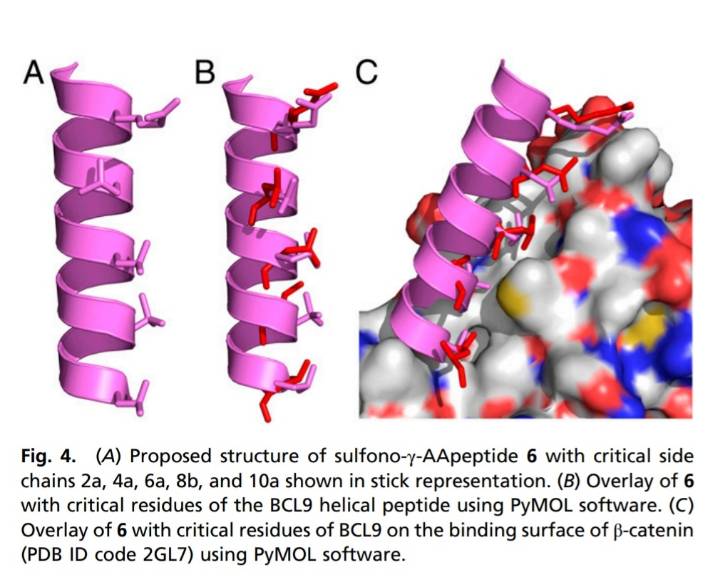
Dr. Jianfeng Cai, together with Dr. Haitao Ji at Moffitt Cancer Center, have recently published a paper in PNAS with the title of “Inhibition of β−Catenin/ B-Cell Lymphoma 9 Protein−Protein Interaction Using α-Helix-Mimicking Sulfono-γ-AApeptide Inhibitors”. Here is the link: https://www.pnas.org/content/early/2019/05/13/1819663116
In this article Dr. Cai and his collaborators reported the use of a new class of peptidomimetics-helical AApeptides to disrupt cancer-related β−Catenin/BCL9 protein-protein interactions.
Kandinsky-Inspired Supramolecular Architectures with High Antibacterial Activity
>> June 16, 2018
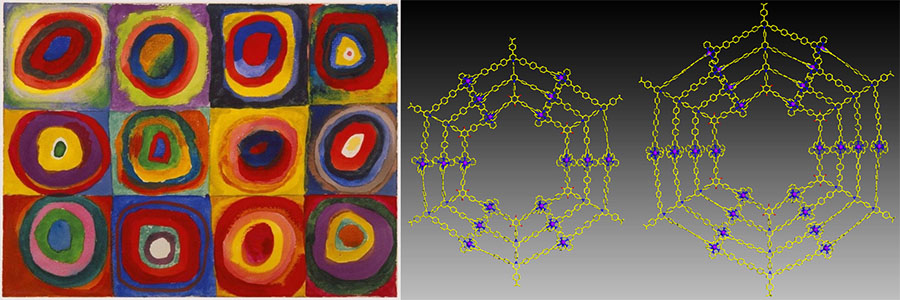 Nested concentric structures widely exist in nature and designed systems with circles,
polygons, polyhedra, and spheres sharing the same center or axis. In the art field,
concentric rings are also known as Kandinsky circles named after Wassily Kandinsky,
a pioneer in abstract art, because of his painting Color Study; Squares with Concentric
Circles. Inspired by Kandinsky, Li, Cai and collaborators recently published a series
of giant nested supramolecular architectures, named Kandinsky Circles in Nature Communications.
In the ligand preparation, consecutive condensation between precursors with primary
amines and pyrylium salts was applied to modularize the synthesis. These discrete
nested supramolecules were prone to assemble into tubular nanostructures through hierarchical
self-assembly. Furthermore, nested supramolecules displayed high antimicrobial activity
against Gram-positive pathogen methicillin-resistant Staphylococcus aureus (MRSA),
and negligible toxicity to eukaryotic cells. This study will shed light into both
antibiotics and supramolecular chemistry field and pave a new avenue into the development
and application of antimicrobial agents.
Nested concentric structures widely exist in nature and designed systems with circles,
polygons, polyhedra, and spheres sharing the same center or axis. In the art field,
concentric rings are also known as Kandinsky circles named after Wassily Kandinsky,
a pioneer in abstract art, because of his painting Color Study; Squares with Concentric
Circles. Inspired by Kandinsky, Li, Cai and collaborators recently published a series
of giant nested supramolecular architectures, named Kandinsky Circles in Nature Communications.
In the ligand preparation, consecutive condensation between precursors with primary
amines and pyrylium salts was applied to modularize the synthesis. These discrete
nested supramolecules were prone to assemble into tubular nanostructures through hierarchical
self-assembly. Furthermore, nested supramolecules displayed high antimicrobial activity
against Gram-positive pathogen methicillin-resistant Staphylococcus aureus (MRSA),
and negligible toxicity to eukaryotic cells. This study will shed light into both
antibiotics and supramolecular chemistry field and pave a new avenue into the development
and application of antimicrobial agents.
Shi Group published in Nature Communication
>> June 4, 2018
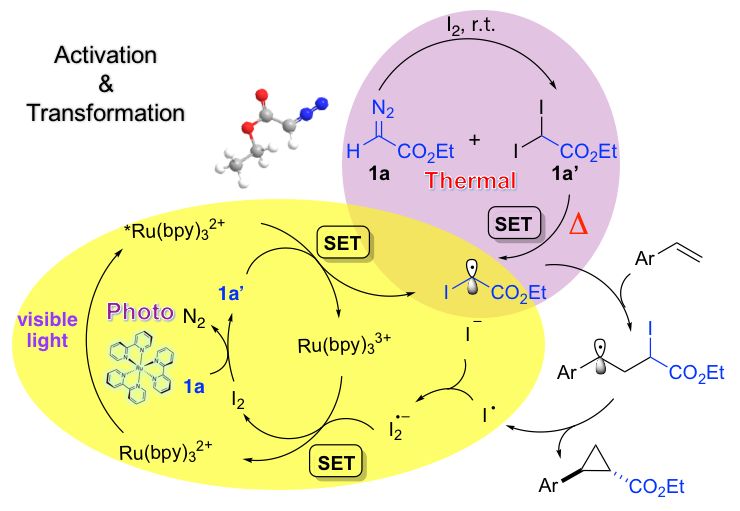
Transition metal catalyzed diazo activation is a classical way to generate metal carbene,
which are valuable intermediates in synthetic organic chemistry. Recently, an alternative
iodine catalyzed diazo activation is disclosed by Shi group under either photo- or
thermal-initiated conditions, which represents an approach to enable carbene radical
reactivity. Dr. Shi and his team reported that this metal-free diazo-activation strategy
were successfully applied into olefin cyclopropanation and epoxidation, and applying
this method to pyrrole synthesis under thermal-initiated conditions further demonstrates
the unique reactivity using this method over typical metal-catalyzed conditions. This
work entitled "Iodine catalyzed diazo activation to access radical reactivity" was
published in Nature Communication in May.
Ma group and collaborators publish bio-inspired uranium nano-traps in Nature Communications
>> May 17, 2018
With nuclear power generation expected to increase over the coming decades to meet
the increasing global energy demand, access to this unconventional reserve is a matter
of energy security. Reserves of such non-renewable raw materials are often limited
to a few countries. Uranium is one such "critical metal" and as estimated by the International
Atomic Energy Agency (IAEA), the total identified conventional resources can only
last for about a century. However, it is estimated that there is an astonishing 4
billion metric tons of uranium dissolved in the Earth's oceans at a concentration
of 3.3 ppb, which is approximately 1000 times more than is available from terrestrial
ores, affording a near limitless supply of uranium. With this knowledge, technology
development capable of sequestering uranium from seawater in an economic manner would
afford a financial backstop, ensure resource accessibility to nations devoid of uranium
reserves, and impede any dramatic fluctuations in the uranium supply chain. Given
the extreme complexity and vast volume of seawater, as well as very low concentration
of uranium in it, to attain this ambitious task demands the design of adsorbents with
high affinity and fast kinetics.
The Ma group we developed an effective approach to regulate uranyl capture performance by creating bio-inspired nano-traps, illustrated by constructing chelating moieties into porous frameworks, where the binding motif's coordinative interaction towards uranyl is enhanced by introducing an assistant group, reminiscent of biological systems. The porous framework bearing 2-aminobenzamidoxime is exceptional in sequestering high uranium concentrations with sufficient capacities (530 mg-1) and trace quantities, including uranium in real seawater (4.36 mg g-1, triple the benchmark).
Cai, Ma, and Van Der Vaart publish novel peptidomimetic architecture in JACS and the paper was selected for the cover of JACS
>> May 7, 2018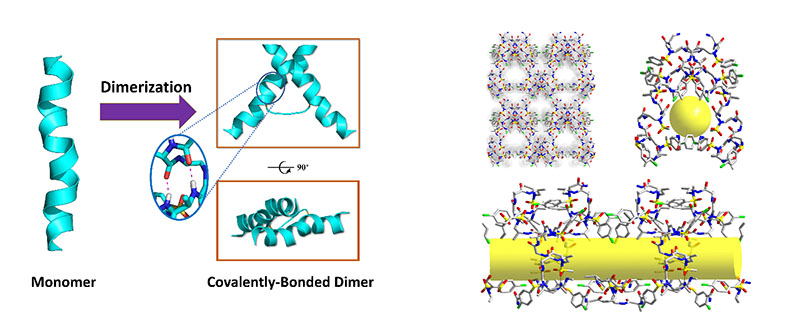
Dr. Jianfeng Cai, collaborated with Dr. Shengqian Ma and Dr. Arjan van der Vaart,
reported a novel hydrogen-bonding-driven 3D assembly of artificial protein (a peptidomimetic
zipper) for the first time by using an α/AApeptide zipper that assembles into a de
novo lattice arrangement through hydrogen-bonded linker-directed interactions as well
as intermolecular C‒Cl∙∙∙Cl‒C halogen bonding and hydrophobic interactions. The JACS
communication paper titled "Hydrogen-Bonding-Driven 3D Supramolecular Assembly of
Peptidomimetic Zipper" was published this May 2, and was selected as the cover. As
the first example of an unnatural peptidic zipper, the dimensional augmentation of
the zipper in this paper differs from metal-coordinated strategies, and may have general
implications for the preparation of peptidic functional materials for a variety of
future applications.
Woodcock group and collaborators publish paper on PETase in PNAS
>> April 23, 2018
A study published in PNAS by Dr. Woodcock (Associate Professor of Chemistry) and collaborators
elucidates how PETase breaks down polyethylene teraphthalate (PET), the most commonly
manufactured plastic material. This enzyme was isolated from a bacterium found in
a Japanese recycling plant in 2016. After its discovery, researchers at the U.S. Department
of Energy's National Renewable Energy Laboratory (NREL), at the University of Portsmouth,
and at the University of South, led a joint interdisciplinary effort to understand
how PETase works. Additionally, during their investigation, they inadvertently improved
the activity of PETase, and Dr. Woodcock and graduate students Fiona Kearns and Ben
Pollard used computational techniques to understand this improved activity.
Woodcock group and collaborators publish paper on PETase in PNAS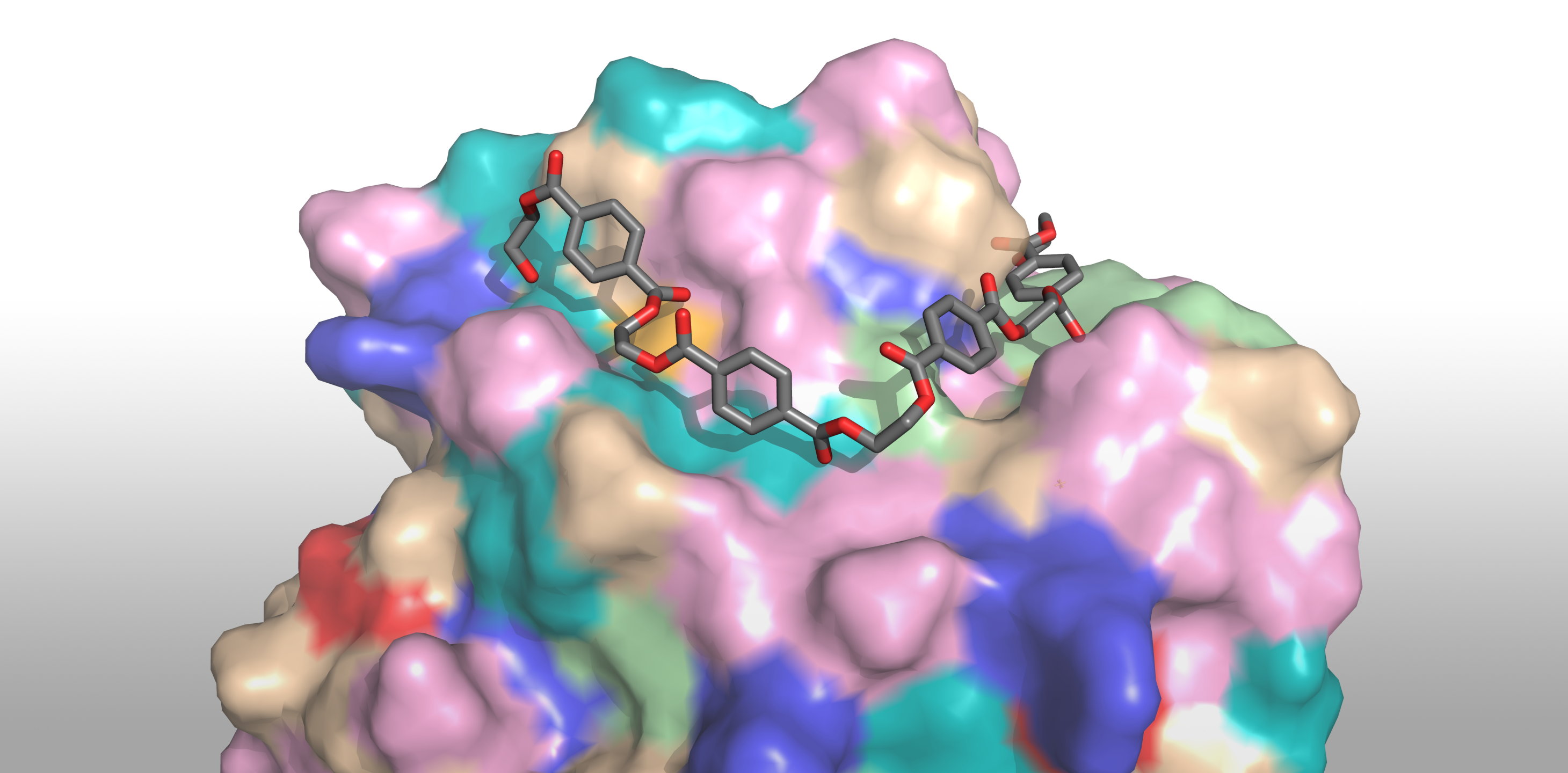
The study is particulary significant, giving the enormous accumulation of plastics
in the environment: it is estimated that 5-13 million metric tons of plastic finds
its way in the ocean every year, corresponding to 1-3 garbage trucks of plastic every
minute.
Li group and collaborators publish emissive supramolecules in Nature Communications
>> February 8, 2018
Coordination-driven self-assembly has emerged as a powerful bottom-up approach to
construct various supramolecular architectures with increasing complexity and functionality.
Dr. Li and his collaborators constructed a series of supramolecular materials with
precisely-controlled rosettes-like structures. Such supramolecules display tunable
emissive properties with respect to different generations, particularly, pure white-light
emission.

Dr. Xiaopeng Li, Assistant Professor in the Chemistry Department at USF, reports the
self-assembly of three generations of giant supramolecules with rosettes-like structures.
Such supramolecules display tunable emissive properties with respect to different
generations, particularly, pure white-light emission. His Nature Communications paper
entitled "Self-assembly of emissive supramolecular rosettes with increasing complexity
using multitopic terpyridine ligands" was published this February.
Most traditional fluorophores only exhibit emission in dilute solution but not in aggregation state due to aggregation caused quenching (ACQ) phenomenon. Dr. Li and his team introduced two levels of restrictions to minimize the intramolecular rotation through elaborate molecular design. They obtained strong emissive supramolecular materials in both solution and aggregation states. Another striking discovery is that G2 exhibited highly pure white light emission property under a wide range of good/poor solvents ratios. The single-component white light emitter is expected to exhibit superior performance improved stability, good reproducibility, and simple device fabrication procedure compared to those multi-component emitters. The team eventually named those structures as supramolecular rosettes, and hopefully, they can give out a bright light in both supramolecular chemistry and emissive materials community to inspire us to seek more complicated structures with tunable properties. The team was also invited by Nature Communications to write a story Behind the Paper.
Gelis group and collaborators publish ground-breaking paper on Hsp90 in Nature Communications
>> January 26, 2018
Dr. Ioannis Gelis, Assistant Professor in the Chemistry Department at USF, reports
a ground-breaking study on the Hsp90 chaperone. His Nature Communications paper entitled
"Phosphorylation induced cochaperone unfolding promotes kinase recruitment and client
class-specific Hsp90 phosphorylation" was published this January. The study shows
how phosphorylation controls the timely progression of the critical Hsp90 machinery
through different steps of the chaperone cycle and resulted in a more complete understanding
of its mechanism, which will aid cancer drug development.
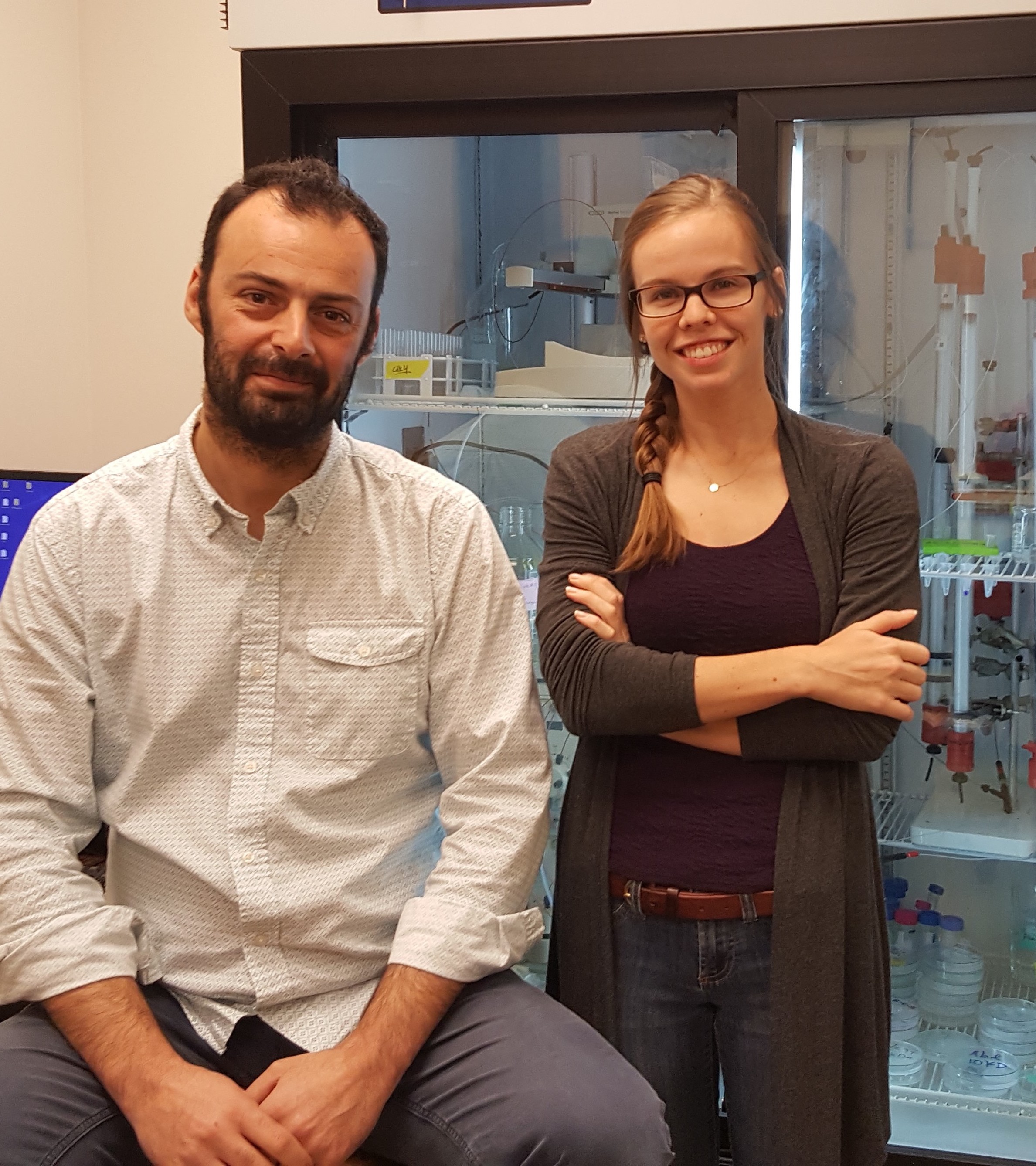
Hsp90 is important for cancer and helps other proteins fold. It needs the Cdc37 cochaperone
to mediate folding of protein kinases, in a cycle regulated by phosphorylation. Using
high field NMR, the Gelis lab showed that phosphorylation of Cdc37 results in partial
unfolding of Cdc37. The unfolding did not affect Cdc37 association with the machinery,
but revealed a SH2 domain binding motif, which recruited other kinases to subsequently
phosphorylate Hsp90. The latter phosphorylation caused dissociation of Cdc37 from
the Hsp90 complex, without affecting the interaction with other cochaperones. Aspects
of the study were validated by cellular experiments in collaboration with Dr. Len
Neckers' group from the National Cancer Institute at NIH, and computer simulations
by Dr. Arjan van der Vaart's group in the Chemistry Department at USF.